Al-Yadudah | |
|---|---|
| Coordinates: 31°51′N35°55′E / 31.850°N 35.917°E | |
| Country | |
| Governorate | Amman Governorate |
| Time zone | UTC + 2 |
Al-Yadudah is a town in the Amman Governorate in northwestern Jordan, located south of the capital Amman. [1]
Al-Yadudah | |
|---|---|
| Coordinates: 31°51′N35°55′E / 31.850°N 35.917°E | |
| Country | |
| Governorate | Amman Governorate |
| Time zone | UTC + 2 |
Al-Yadudah is a town in the Amman Governorate in northwestern Jordan, located south of the capital Amman. [1]
The town is the site of the family estate of a Christian family called Abu Jaber who trace their ancestry approximately back to the cities of Salt and Nazareth. The estate was established in the 1850s. A large number of those who became sharecroppers at the Yadudah estate were descendants of the Balgawi bedouin family, who fondly remember entering into an alliance with the Abu Jaber family and protecting them from other bedouin families who also occupied the environs. The name Al Yadudah has come to stand in for the small town that surrounds the mansion and estate that was named Al Yadudah by the Abu Jabers. [2] A group of scholars argue that this village, inside its walled perimeter, had contributed greatly to the cultivation and domestication of the land, or "sedentarization." [3]
This alliance with the Balgawis has since faded, and the estate is now the home of a Jordanian heritage center, gift shop, photography studio, and restaurant called Kan Zaman (كان زمان in Arabic), meaning "once, long ago." The site has been run by Jordanian tourism authorities, and opened its doors in 1989 as a tourism attraction that seeks to provide an authentic experience of rural Jordan as it existed in the 19th century. [4]
The restaurant serves traditional Jordanian dishes, and the photography studio allows guests to capture themselves in the midst of a historical, traditional environment. The center seeks to bring the hospitality of Jordanian bedouin culture to its visitors.
Like all towns and cities in the Levant, a descendant of the original family, Raouf Abujaber, explains that the estate of Al Yadudah had over 300 wells and numerous cisterns that formed an integral part of the region's natural resource economy and economic interdependence. [5]
Daviau and Battenfield mention that near the modern town of Al Yadudah is the Madaba Plains Project, which began in 1994. The nearby town of Tall al-'Umayri had been excavated and studied for changes in its food system between sedentary and nomadic economies. [2]
Andrew Shyrock argues that the estate, and now restaurant, does portray some accurate images of a slice of 19th-century Jordanian life. However, the restaurant may portray Jordanian life as an exotic image in the minds of visitors, especially its mostly Arab visitors. This includes food, traditional dress and musical instruments, jewelry, and other souvenirs. Shyrock argues that the estate sees Jordanian past as monolithic. [4]
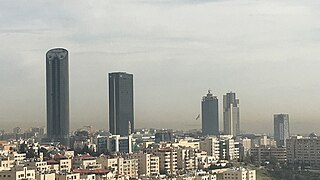
Amman is the capital and the largest city of Jordan, and the country's economic, political, and cultural center. With a population of 4,061,150 as of 2021, Amman is Jordan's primate city and is the largest city in the Levant region, the fifth-largest city in the Arab world, and the tenth-largest metropolitan area in the Middle East.

As-Salt, also known as Salt, is an ancient trading city and administrative centre in west-central Jordan. It is on the old main highway leading from Amman to Jerusalem. Situated in the Balqa highland, about 790–1,100 metres above sea level, the city is built in the crook of three hills, close to the Jordan Valley. One of the three hills, Jabal al-Qal'a, is the site of a 13th-century ruined fortress. It is the capital of Balqa Governorate of Jordan.
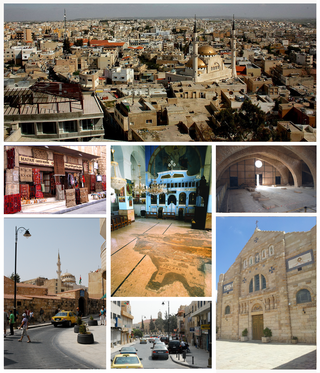
Madaba is the capital city of Madaba Governorate in central Jordan, with a population of about 60,000. It is best known for its Byzantine and Umayyad mosaics, especially a large Byzantine-era mosaic map of the Holy Land. Madaba is located 30 kilometres south-west of the capital Amman.

Wadi Rum, known also as the Valley of the Moon, is a valley cut into the sandstone and granite rock in southern Jordan, near the border with Saudi Arabia and about 60 km (37 mi) to the east of the city of Aqaba. With an area of 720 km2 (280 sq mi) it is the largest wadi in Jordan.

Dhiban, known to the Moabites as Dibon, is a Jordanian town located in Madaba Governorate, approximately 70 kilometres south of Amman and east of the Dead Sea. Previously nomadic, the modern community settled the town in the 1950s. Dhiban's current population is about 15,000, with many working in the army, government agencies, or in seasonal agricultural production. A number of young people study in nearby universities in Karak, Madaba, and Amman. Most inhabitants practice Islam.

The culture of Jordan is based on Arabic and Islamic elements. Jordan stands at the intersection of the three continents of the ancient world, lending it geographic and population diversity. Notable aspects of the culture include the traditional music and clothing of Jordan and interest in sports. These include football and basketball as well as other sports such as equestrianism, fencing, karate, swimming, and table tennis
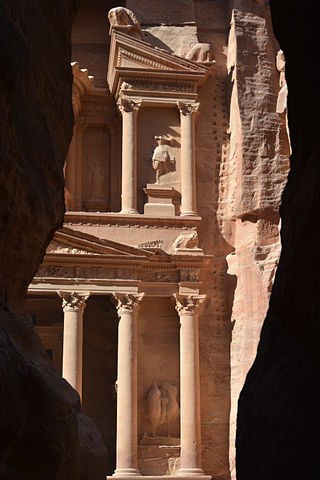
Al-Khazneh, akaKhazneh el-Far'oun, is one of the most elaborate rock-cut tombs in Petra, a city of the Nabatean Kingdom inhabited by the Arabs in ancient times. As with most of the other buildings in this ancient town, including the Monastery, this structure was carved out of a sandstone rock face.
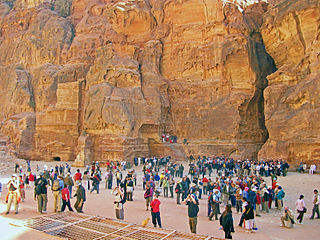
Jordan is a sovereign Arab state in the Middle East. The capital, Amman, is Jordan's most populous city as well as the country's economic, political and cultural centre.
The Umayyad desert castles, of which the desert castles of Jordan represent a prominent part, are fortified palaces or castles in what was the then Umayyad province of Bilad al-Sham. Most Umayyad "desert castles" are scattered over the semi-arid regions of north-eastern Jordan, with several more in Syria, Israel and the West Bank (Palestine).

The Amman Citadel is an archeological site at the center of downtown Amman, the capital of Jordan. The L-shaped hill is one of the seven hills (jabals) that originally made up Amman.

The Jordan River Foundation is a Nonprofit organization, started in the early 1990s in Amman, Jordan to empower society, especially women and children, and in turn, improve the quality of life to secure a better future for all Jordanians. It was founded by Queen Nour Al Hussein, who was its first chair. After the death of her husband, King Hussein bin Talal, she left the position, which was taken over by Queen Rania Al-Abdullah.
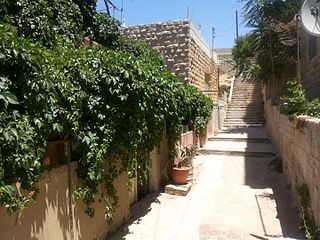
Armenians in Jordan are ethnic Armenians living in the Hashemite Kingdom of Jordan. There are an estimated 3,000 Armenians living in the country today with an estimated 2,500 of them being members of the Armenian Apostolic Church, and predominantly speak Western Armenian dialect. Armenians make up the biggest majority of non-Arab Christians in the country.

Tall Jawa is an archaeological and historical site in central Jordan.

Tall al-’Umayri is an archaeological dig site in western Jordan that dates from the Early Bronze Age to the Hellenistic period. It is located near the modern capital of Amman, and is significant for its well-preserved evidence of a temple, as well as archaeological evidence of a network of small farms believed to produce wine. Excavations were proceeding as of 2014.
Jalul is an archaeological site and small village in the Amman Governorate in northwestern Jordan.
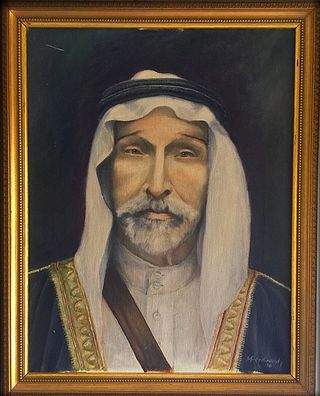
Haditha Ali Abdullah Al-Khraisha was a Jordanian Bedouin tribal sheikh. He was one of the two paramount sheikhs of the Bani Sakhr Tribe, arguably the most powerful tribe in Jordan. Haditha headed the northern clans of the Bani Sakher (al-Ka'abnah), while Mithgal Al-Fayez headed the other half, (al-Twaga). In the early twentieth century, Haditha and the Bani Sakhr, in addition to other Trans-Jordanian tribes such as the Huweitat and the Belqawiah, fought the Wahhabi Ikhwan, a religious militia who helped establish Abdul Aziz Ibn Saud as the first King of Saudi Arabia. The Wahhabi Ikhwan were Abdul Aziz Ibn Saud's tool for territorial expansion and lent religious legitimacy to Ibn Saud's territorial and political ambitions. According to King Faisal Al Saud the armed resistance that Bani Sakhr put up against Ibn Saud and the Wahhabi Ikhwan was "the reason that Saudi Arabia's borders do not extend all the way to Palestine and why the Al Sauds never became the rulers of the Levant". Haditha was known throughout Arabia for his wisdom and chivalry, He played a significant role in building the nascent Jordanian state and shaping its development. An ally and supporter of King Abdullah I, Haditha served several terms as Senator and Parliamentarian, including the first Jordanian Senate in 1947 which consisted of only ten members. Haditha was also elected to the second Legislative Council in June 1931, and the Fourth Legislative Council in 1937 while Jordan was still an Emirate. Haditha was also one of the founding members of the Jordanian Solidarity Party in March 1933. Sheikh Haditha also cultivated the oasis of Azraq, Jordan.
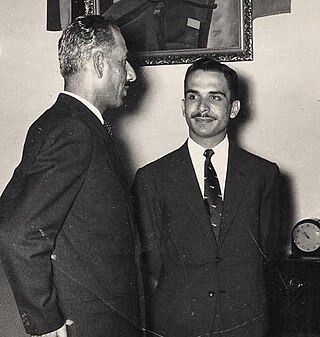
Al-Musharbash is a prominent Christian Jordanian family who have resided in Jordan since the 1600s. It is thought that they are descendants of the historical Ghassanid dynasty through one of the 12 sons of King Amr IV, who ruled over a large portion of the Middle East in the early 7th century. The claim is mainly through oral tradition, and a document from 1338 found in Bechamoun, Lebanon, written by Sheikh Salem Al-Wahban from the Sayegh tribe, tracing the family tree of King Amr IV. Some of the other Greek Orthodox families in Jordan share the same lineage.
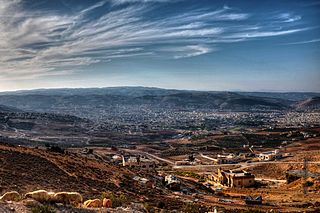
The Balqa, known colloquially as the Balga, is a geographic region in central Jordan generally defined as the highlands east of the Jordan Valley in between the Zarqa River to the north and the Wadi Mujib gorge to the south.

Ammar Khammash is a Jordanian architect, designer and artist. His work is based on the integration of building designs with nature and the surrounding environment. His projects helped revive Pella and Jordan Valley by creating two rest stops.
The Madaba Plains Project, or MPP, was founded by veterans of the Heshbon Expedition to continue archaeological survey and excavations research in the hills and plains between Amman and Madaba. MPP is notable for its longevity and influence on archaeology in Jordan. An estimated 2,000 plus students, volunteers and professors have participated in MPP's projects over the past fifty years and MPP is considered Jordan's longest ongoing archaeological project.